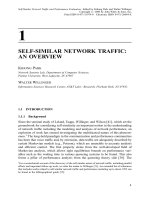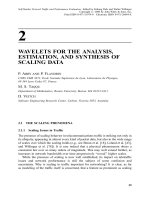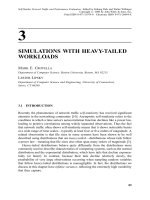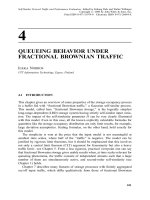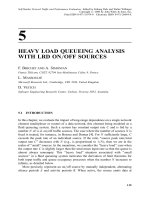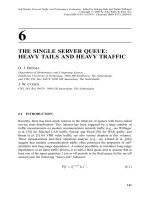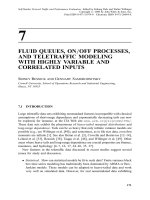Tài liệu Mạng lưới giao thông và đánh giá hiệu suất P9 pptx
Bạn đang xem bản rút gọn của tài liệu. Xem và tải ngay bản đầy đủ của tài liệu tại đây (203.72 KB, 34 trang )
9
BUFFER ASYMPTOTICS FOR M=G=
INPUT PROCESSES
A
RMAND
M. M
AKOWSKI AND
M
INOTHI
P
ARULEKAR
Institute for Systems Research, and Department of Electrical and Computer Engineering,
University of Maryland, College Park, MD 20742
9.1 INTRODUCTION
Several recent measurement studies have concluded that classical Poisson-like traf®c
models do not account for time dependencies observed at multiple time scales in a
wide range of networking applications, for example, Ethernet LANs [13, 20, 33],
variable bit rate (VBR) traf®c [3, 15], Web traf®c [6], and WAN traf®c [31]. As the
resulting temporal correlations are expected to have a signi®cant impact on buffer
engineering practices, this ``failure of Poisson modeling'' has generated an increased
interest in a number of alternative traf®c models that capture observed (long-range)
dependencies [14, 24]. Proposed models include fractional Brownian motion [25]
and its discrete-time analog, fractional Gaussian noise [1]. Already both have
exposed clearly the limitations of traditional traf®c models in predicting storage
requirements and devising congestion controls. A discussion of these issues in the
case of fractional Brownian motion is summarized in Chapter 4.
In this chapter we focus instead on the class of M =G= input processes as
potential traf®c models. An M=G= input process is understood as the busy server
process of a discrete-time in®nite server system fed by a discrete-time Poisson
process of rate l (customers=slot) and with generic service time s distributed
according to G. As argued in Parulekar [27] and Parulekar and Makowski [29], these
M=G= input processes constitute a viable alternative to existing traf®c models;
reasons range from ¯exibility to tractability.
Self-Similar Network Traf®c and Performance Evaluation, Edited by Kihong Park and Walter Willinger
ISBN 0-471-31974-0 Copyright # 2000 by John Wiley & Sons, Inc.
215
Self-Similar Network Traf®c and Performance Evaluation, Edited by Kihong Park and Walter Willinger
Copyright # 2000 by John Wiley & Sons, Inc.
Print ISBN 0-471-31974-0 Electronic ISBN 0-471-20644-X
First, the relevance of the M=G= input model to network traf®c modeling is
perhaps best explained through its connection to an attractive model for aggregate
packet streams proposed by Likhanov et al. [21]. They show that the combined
traf®c generated by several independent, identically distributed (i.i.d.) on=off sources
with Pareto distributed activity periods behaves in the limit, as the number of sources
increases, like the M =G= input stream with a Paretodistributed s. This provides a
rationale for the view that M=G= input processes could provide a natural
alternative to existing traf®c models, at least for certain multiplexed applications.
Second, the class of M =G= input processes is stable under multiplexing; that is,
the superposition of several M =G= processes can be represented by an M =G=
input process.
Third, the M =G= model displays great ¯exibility in capturing positive
dependencies over a wide range of time scales; this is achieved very simply through
the tail behavior of s (Proposition 9.4.1). The degree of positive correlation can
further be characterized by the sum of the autocovariances, or index of dispersion of
counts (IDCs), with the process being short-range dependent (SRD) (i.e., IDC ®nite)
if and only if Es
2
is ®nite (Proposition 9.5.1).
Insights into how temporal correlations of M=G= input processes will affect
queueing performance can be gained by analyzing the behavior of a multiplexer fed
by an M =G= input process. For simplicity, we model the multiplexer as a discrete-
time single server system consisting of an in®nite size buffer and a server with a
constant release rate c (cells=slot). The number of customers in the input buffer at
time t is denoted by q
t
. Our performance index is the steady-state buffer tail
probability Pq
> b, as this quantity is indicative of the buffer over¯ow prob-
ability in a corresponding ®nite buffer system with b positions.
Computing these tail probabilities, either analytically or numerically, represents a
challenging problem in the absence of any underlying Markov property for M =G=
inputs. Instead, we focus on the simpler task of determining the asymptotic tail
behavior of the queue-length distribution for large buffer size. More precisely, we
seek results of the form
lim
b
1
hb
ln Pq
> bg 9:1
for some positive constant g and mapping h : R
R
; these quantities are
characterized by l, G, and c and should be easily computable. Limits such as Eq.
(9.1) suggest approximations of the form
Pq
> be
hbg
b : 9:2
Needless to say, such estimates should be approached with care [5]. Nonetheless, Eq.
(9.1) already provides some qualitative insights intothe queueing behavior at the
multiplexer and could, in principle, be used to produce guidelines for sizing up its
buffers.
216
BUFFER ASYMPTOTICS FOR M=G= INPUT PROCESSES
In this chapter we provide an overview of some recent work on this issue.
Drastically different behaviors emerge depending on whether v
t
* Ot or v
t
* ot
(with t ), where v
t
* ln P
^
s > t; t 1; 2; ..., and
^
s is the forward
recurrence time (9.9) associated with s. The case v
t
* Ot is associated with the
service time s having exponential tails, while the case v
t
* ot corresponds to
heavy or subexponential tails for s.
Our focus here is primarily (but not exclusively) on large deviations techniques in
order to obtain Eq. (9.1). This approach has already been adopted by a number of
authors [10, 16, 19]. Applying results by Duf®eld and O'Connell [10] (and some
recent extensions thereof [11, 30]), we are able to compute hb and g under
reasonably general conditions. In fact, for a large class of distributions, we can select
hbv
b
* , and the asymptotics (9.1) and (9.2) then take the compact form
Pq
> bP
^
s > b
g
b : 9:3
Hence, in many cases, including Weibull, lognormal, and Pareto service times, q
and
^
s (thus s) belong to the same distributional class as characterized by tail
behavior.
In many cases of interest, in lieu of Eq. (9.1), these large deviations techniques
yield only the weaker asymptotic bounds
g
lim inf
b
1
hb
ln Pq
> b9:4
and
lim sup
b
1
hb
ln Pq
> by* 9:5
with g
g*. This situation typically occurs when s is heavy tailed (more generally,
subexponential) with either ®nite or in®nite Es
2
, in which case large deviations
excursions are only one of several causes for buffer exceedances [19]. While Eqs.
(9.4) and (9.5) are still useful in providing bounds on decay rates, they will not be
tight in the heavy-tail case and other approaches are needed. Of particular relevance
are the approaches of Liu et al. [22] (summarized in Section 9.11) and of Likhanov
(discussed in Chapter 8). Liu et al. [22] derive bounds through direct arguments that
rely on the asymptotics of Pakes [26] for the GI =GI =1 queue under subexponential
assumptions [12]. While Likhanov presents lower and upper bounds only when s is
Pareto, these bounds are asymptotically tight. Results for the continuous-time model
can be found in Jelenkovic and Lazar [17], and in Chapters 10 and 7.
Comparison of Eq. (9.3) with results from Norros [25] and Parulekar and
Makowski [28] points already to the complex and subtle impact of (long-range)
dependencies on the tail probability Pq
> b. Indeed, in Norros [25] the input
stream to the multiplexer was modeled as a fractional Gaussian noise process (or
rather its continuous-time analog) exhibiting long-range dependence (in fact, self-
similarity), and the buffer asymptotics displayed Weibull-like characteristics. On the
other hand, by the results described above, an M=G= input process with a Weibull
9.1 INTRODUCTION
217
service time also yields Weibull-like buffer asymptotics although the input process is
now short-range dependent. Hence, the same asymptotic buffer behavior can be
induced by two vastly different input streams, one long-range dependent and the
other short-range dependent! To make matters worse, if the pmf G were Pareto
instead of Weibull, the input process would now be long-range dependent, in fact
asymptotically self-similar [28], but the buffer distribution would now exhibit
Pareto-like asymptotics, in sharp contrast with the results of Norros [25].
To reiterate the main conclusion of Parulekar and Makowski [28], the value of the
Hurst parameter as the sole indicator of long-range dependence (via asymptotic self-
similarity) is at best questionable as it does not characterize buffer asymptotics by
itself. Furthermore, buffer sizing cannot be determined adequately by appealing
solely to the short- versus long-range dependence characterization of the input
model used, be it of the M =G= type or otherwise. Of course, this is not too
surprising since long-range dependence (and its close cousin, second-order self-
similarity) is determined by second-order properties of the input process, while
asymptotics of the form (9.1) invoke much ®ner probabilistic properties, which are
embedded here in the sequence v
t
*; t 1; 2; .... The ®niteness of Es
2
(which
characterizes the SRD nature of the M=G= input process) is obviously a poor
marker for predicting the behavior of this sequence.
To close, we note that the diverse queueing behavior demonstrated here is tied to
the tail behavior of s, which determines the correlation structure of M=G= inputs.
This clearly illustrates the tremendous impact that the correlation structure of an
input stream can have on the corresponding queueing performance given that the
M=G= inputs all have Poisson marginals! One more data point for the need of a
cautious approach in modeling network traf®c when time dependencies are either
observed or suspected.
9.2 THE M=G= INPUT PROCESS
We summarize various facts concerning the busy server process of a discrete-time
M=G= system; details are available in Parulekar [27].
9.2.1 The Model
Consider a system with in®nitely many servers. During time slot t; t 1; b
t1
new
customers enter the system. Customer i; i 1; ...; b
t1
, is presented toits own
server and begins service by the start of slot t 1; t 2; its service time has
duration s
t1;i
(expressed in number of slots). Let b
t
denote the number of busy
servers or, equivalently, of customers still present in the system, at the beginning of
slot t; t 1. We assume that b servers are initially present in the system at t 0
(i.e., at the beginning of slot 0; 1) with customer i; i 1; ...; b, requiring an
amount of work of duration s
0;i
from its own server. The busy server process
b
t
; t 0; 1; ... is what we refer toas the M=G= input process.
218
BUFFER ASYMPTOTICS FOR M=G= INPUT PROCESSES
The following assumptions are enforced on the R-valued random variables (rvs)
b, b
t1
; t 0; 1; ... and s
t;i
; t 0; 1; ...; i 1; 2; ...: (1) The rvs are
mutually independent; (2) The rvs b
t1
; t 0; 1; ... are i.i.d. Poisson rvs with
parameter l > 0; (3) The rvs s
t;i
; t 1; 2; ...; i 1; 2; ... are i.i.d. with
common pmf G on 1; 2; .... We denote by s a generic R-valued rv distributed
according to the pmf G. Throughout we assume this pmf G tohave a ®nite ®rst
moment, or equivalently, Es < . At this point, no additional assumptions are
made on the rvs s
0;i
; i 1; 2; ....
For each t 0; 1; ..., we note the decomposition
b
t
b
0
t
b
a
t
; 9:6
where the rvs b
0
t
and b
a
t
describe the contributions to the number of customers in
the system at the beginning of slot t; t 1 from those initially present (at t 0)
and from the new arrivals in the interval [0, t], respectively. Under the enforced
operational assumptions, we readily check that
b
a
t
P
t
s1
P
b
s
i1
1s
s;i
> t s and b
0
t
P
b
i1
1s
0;i
> t: 9:7
The rv b
a
t
can alsobe interpreted as the number of busy servers in the system at the
beginning of slot t; t 1 given that the system was initially empty (i.e., b 0).
9.2.2 The Stationary Version
Although the busy server process b
t
; t 0; 1; ... is in general not a (strictly)
stationary process, it does admit a stationary and ergodic version b
t
*; t 0; 1; ....
This stationary version satis®es the decomposition (9.6) with the portion in (9.7) due
to the initial condition replaced by
b
0
t
P
b
n1
1
^
s
n
> t; t 0; 1; ...; 9:8
where (1) the rvs b and
^
s
n
; n 1; 2; ... are independent of the rvs
b
t1
; t 0; 1; ... and s
t;i
; t 1; 2; ...; i 1; 2; ...; (2) the rvs
^
s
n
; n 1; 2; ... are independent of the rv b, which is Poisson distributed with
parameter lEs; and (3) the rvs
^
s
n
; n 1; 2; ... are i.d.d. rvs distributed
according to the forward recurrence time
^
s associated with s; the corresponding
equilibrium pmf
^
G of
^
s is given by
P
^
s r
Ps r
Es
; r 1; 2; ...: 9:9
9.2 THE M=G= INPUT PROCESS
219
The following properties of b
t
*; t 0; 1; ... follow readily from this repre-
sentation [7, 18 (Theorem 3.11, p. 79), 27].
Proposition 9.2.1. The stationary and ergodic version b
t
*; t 0; 1; ... of the
busy server process has the following properties:
(i) For each t 0; 1; ..., the rv b
t
* is a Poisson rv with parameter lEs.
(ii) The process is reversible in that
b
0
*; b
1
*; ...; b
t
*
st
b
t
*; b
t1
* ; ...; b
0
*; t 0; 1; ...: 9:10
9.3 THE BUFFER SIZING PROBLEM
As we shall see shortly in Sections 9.4 and 9.5, M =G= input processes display an
extremely rich correlation structure. We expect these temporal correlations to have a
signi®cant impact on queueing performance when such processes are offered to
a multiplexer. Togain some insights intothis basic issue we map a multiplexer intoa
discrete-time single server queue with in®nite capacity and constant release rate of c
cells=slot under the ®rst-come-®rst-served discipline. The cell stream is modeled by
an M=G= input process as de®ned above, with b
t1
representing the number of
new cells that arrive at the start of time slot t; t 1. Let q
b
t
denote the number of
cells remaining in the buffer by the end of slot t 1; t, sothat q
b
t
b
t1
cells are
ready for transmission during slot t; t 1. If the multiplexer output link can
transmit c cells=slot, then the buffer content sequence q
b
t
; t 0; 1; ... evolves
according to the Lindley recursion
q
b
0
q; q
b
t1
q
b
t
b
t1
c
; t 0; 1; ...; 9:11
for some initial condition q.
Conditions under which the queueing system (9.11) admits a steady-state regime
are well known and are given next.
Proposition 9.3.1. If lEs < c, then there exists an R
-valued rv q
b
such that
q
b
t
t
q
b
for any choice of the initial conditions q, b, and s
0;i
; i 1; 2; .... The
system is then said to be stable.
This characterization of stability follows by extending Loynes's result [23] to
Lindley recursions driven by sequences that couple with their stationary and ergodic
versions [2]. Here, for any choice of the initial conditions b and s
0;i
; i 1; 2; ...,
the sequence b
t1
; t 0; 1; ... indeed couples in ®nite time with the stationary
and ergodic version introduced in Proposition 9.2.1.
220
BUFFER ASYMPTOTICS FOR M=G= INPUT PROCESSES
Stationary M =G= processes being time-reversible, we have the representation
q
b
st
supS
b
t
ct; t 0; 1; ...9:12
for the steady-state buffer content q
b
with
S
b
0
0; S
b
t
b
1
* b
t
*; t 1; 2; ...: 9:13
Hereafter, by an M =G= input process we mean its stationary version
b
t
*; t 0; 1; ..., which is fully characterized by the pair l; G. Moreover, from
now on, we always assume the stability condition
r
in
lEs < c: 9:14
9.4 SECOND-ORDER CORRELATIONS
Before discussing the asymptotics associated with buffer over¯ow induced by
M=G= input processes, we make a slight detour to explore the correlation
structure of such input processes.
9.4.1 Correlation Properties
In view of Proposition 9.2.1, the stationary version b
t
*; t 0; 1; ... has a well-
de®ned (auto)covariance function G : R R,say,
GhCovb
t
*; b
th
* ; t; h 0; 1; ...: 9:15
Proposition 9.4.1. We have
GhlEs h
lEsP
^
s > h; h 0; 1; ... : 9:16
The ®rst equality in Eq. (9.16) is established in Cox and Isham [7] and the second
equality follows readily from the de®nition (9.9). From Eq. (9.16) we ®nd the
autocorrelation function g : R R of the M =G= process l; s tobe given by
gh
Gh
G0
P
^
s > h; h 0; 1; ...: 9:17
Note that g01 as we recall that Ps > 01.
9.4.2 Inverting g
Proposition 9.4.1 shows that the correlation structure of the stationary M =G=
input process l; s is completely determined by the pmf of
^
s (thus of s). It turns out
9.4 SECOND-ORDER CORRELATIONS
221
that the inverse is true as well. Indeed, Eqs. (9.9) and (9.17) together imply
ghgh 1P
^
s > hP
^
s > h 1
1
Es
Ps > h; h 0; 1; ...; 9:18
sothat the mapping h gh is necessarily decreasing and integer-convex. Taking
intoaccount the facts g01 and Ps > 01, we conclude from Eq. (9.18) (with
h 0) that
Es
1
1 g19:19
with g1 < 1 necessarily by the ®niteness of Es. Combining Eqs. (9.18) and
(9.19) we ®nd that
Ps > h
ghgh 1
1 g1
; h 0; 1; ...: 9:20
Note also from Eq. (9.20) that
Es
P
h0
Ps > h
1 lim
h
gh
1 g1
9:21
and Eq. (9.19) imposes lim
h
gh0. A moment of re¯ection readily leads to the
following invertibility result.
Proposition 9.4.2. An R
-valued sequence gh; h 0; 1; ... is the autocor-
relation function of the M=G= process l; s with integrable s if and only if
the corresponding mapping h gh is decreasing and integer-convex with
g01 > g1 and lim
h
gh0, in which case the pmf G of s is given by
Eq. (9.20).
9.5 LONG-RANGE DEPENDENCE
The existence of positive correlations in the sequence b
t
*; t 0; 1; ... is clearly
apparent from Eq. (9.16). The strength of such positive correlations can be
formalized in several ways, which we now describe; additional material is available
in Cox [8] and we refer the reader to Tsybakov and Georganas [32] for a discussion
of alternative de®nitions.
The sequence b
t
*; t 0; 1; ... is said tobe short-range dependent (SRD) if
P
h0
Gh < : 9:22
222
BUFFER ASYMPTOTICS FOR M=G= INPUT PROCESSES
Otherwise, the sequence b
t
*; t 0; 1; ... is said tobe long-range dependent
(LRD). Easy calculations using Eq. (9.16) readily lead to the following simple
characterization.
Proposition 9.5.1. We have
P
h0
Gh
l
2
Ess 1 9:23
so that the process is SRD if and only if Es
2
is ®nite.
Interesting subclasses of LRD processes can further be identi®ed through the
notion of second-order self-similarity. To do so, we introduce the rvs
b
m
t
1
m
P
m1
k0
b*
mtk
; m 1; 2; ...;t 0; 1; ...: 9:24
For each m 1; ..., the rvs b
m
t
; t 0; 1; ... form a (wide-sense) stationary
sequence with correlation structure de®ned by
G
m
hCovb
m
t
; b
m
th
and g
m
h
G
m
h
G
m
0
; h 0; 1; ...: 9:25
For each H > 0 consider the mapping g
H
: R R
given by
g
H
h
1
2
h 1
2H
2h
2H
h 1
2H
; h 0; 1; ...: 9:26
We say that the sequence b
t
*; t 0; 1; ... is exactly (second-order) self-similar if
Varb
m
t
d
2
m
b
; m 1; 2; ... 9:27
for some constants d
2
> 0 and 0 < b < 1, a requirement equivalent to
Ghd
2
g
H
h; h 0; 1; ...; 9:28
where H 1 b=2 is known as the Hurst parameter of the process. The parameter
H being in the range (0.5, 1), the mapping g
H
is strictly decreasing and integer-
convex, with g
H
01, and behaves asymptotically as
g
H
hH2H 1h
2H2
h : 9:29
9.5 LONG-RANGE DEPENDENCE
223
By Proposition 9.4.2 we can interpret g
H
as the autocorrelation function of the
M=G= input process l; s
H
with
Ps
H
> r
r 2
2H
3r 1
2H
3r
2H
r 1
2H
41 2
2H2
; r 1; 2; ...;
sothat the M =G= input process l; s
H
is exactly second-order self-similar with
Hurst parameter H.
In applications, the notion of exact self-similarity is often too restrictive and is
weakened as follows. The sequence b
t
*; t 0; 1; ... is said tobe asymptotically
(second-order) self-similar if
lim
m
g
m
hg
H
h; h 1; 2; ...: 9:30
This will happen for the M =G= input process l; s if
Ps > rr
a
Lr; 9:31
with 1 < a < 2, for some slowly varying function L : R
R
, in which case
H 3 a=2.
9.6 GENERAL BUFFER ASYMPTOTICS
Several authors [10, 16, 19] have derived asymptotics such as (9.1) by means of
large deviations estimates associated with the sequence t
1
S
b
t
ct; t 0; 1; ....
These results (and their necessary extensions) are summarized below as they apply to
the present context.
9.6.1 A General Setup
With a given R-valued sequence x
t1
; t 0; 1; ..., we associate the R
-valued rv
q
given by
q
supS
t
; t 0; 1; ...; 9:32
where
S
0
0; S
t
x
1
x
t
; t 1; 2; ...: 9:33
If the sequence x
t1
; t 0; 1; ... is assumed stationary and ergodic with
Ex
1
< 0, then q
is a.s. ®nite. We are interested in characterizing the asymptotic
behavior of the tail probability Pq
> b for large b.
224
BUFFER ASYMPTOTICS FOR M=G= INPUT PROCESSES
To ®x the terminology, a scaling sequence is any monotone increasing R-valued
sequence v
t
; t 0; 1; ... such that lim
t
v
t
. The sequence t
1
S
t
,
t 1; 2; ... is said tosatisfy the large deviations principle under scaling v
t
if
there exists a lower-semicontinuous function I : R 0; such that for every
open set G,
inf
xG
Ixlim inf
t
1
v
t
ln Pt
1
S
t
G9:34
and for every closed set F,
lim sup
t
1
v
t
ln Pt
1
S
t
Finf
xF
Ix: 9:35
We refer toEqs. (9.34) and (9.35) as the large deviations lower and upper bounds,
respectively. The rate function I is said to be good if for each r > 0, the level set
x R : Ixr is a compact subset of R. Additional information on large
deviations can be found in Dembo and Zeitouni [9].
We consider a given scaling sequence v
t
; t 0; 1; ... with the property that
there exist functions g, h : R
R
such that h is monotone increasing with
lim
b
hb, and the limits
lim
b
v
b=y
hb
lim
b
v
b=y
hb
gy; y > 0 9:36
exist with x (resp. x) denoting the ceiling (resp. ¯oor) of x.
9.6.2 A Lower Bound
The following theorem is essentially due to Duf®eld and O'Connell [10]; a proof is
included here for the sake of completeness.
Proposition 9.6.1. If the process t
1
S
t
; t 1; 2; ... satis®es the large deviations
lower bound (9.34) with good rate function I : R 0; (under scaling v
t
), then
we have Eq. (9.4) with
g
inf
y>0
gy inf
x>y
Ix
: 9:37
Proof. Fix b > 0 and y > 0. From the de®nition of q
, we ®nd
Pq
> bP
S
b=y
b=y
>
b
b=y
P
S
b=y
b=y
> y
9:38
9.6 GENERAL BUFFER ASYMPTOTICS
225
sothat
1
hb
ln Pq
> b
v
b=y
hb
1
v
b=y
ln P
S
b=y
b=y
> y
: 9:39
Letting b gotoin®nity in this last inequality, we get
lim inf
b
1
hb
ln Pq
> bgy inf
x>y
Ix9:40
upon invoking Eq. (9.36) and the lower bound (9.34) (with G ; y). This is
essentially Theorem 2.1 of Duf®eld and O'Connell [10] and shows the local nature
of the lower bound. As the best lower bound is the largest, we can immediately
sharpen (9.40) intothe lower bound (9.4) with g
given by (9.37). j
The existence of (9.34) (and for that matter, of (9.35)) is typically validated
through the GaÈrtner±Ellis theorem [9, Theorem 2.3.6, p. 45]. In that context, for each
t 1; 2; ..., we de®ne
L
t
y
1
v
t
ln E exp
yv
t
t
S
t
; y R; 9:41
and it is required that for each y in R, the limit
Ly lim
t
L
t
y9:42
exists (possibly as an extended real number). Under broad conditions, the process
t
1
S
t
; t 1; 2; ... then satis®es the large deviations principle under scaling v
t
with good rate function L* : R 0; , where L* is the Legendre±Fenchel
transform of the mapping L : R ; de®ned through Eq. (9.42), namely,
L*zsup
yR
yz Ly; z R: 9:43
Expression (9.37) simpli®es when the large deviations principle for the process
t
1
S
t
; t 1; 2; ... holds with a good rate function I : R 0; , which is
convex. Indeed, the relation
inf
xR
IxI Ex
1
9:44
follows readily from the goodness of I and the fact that lim
t
t
1
S
t
Ex
1
< 0
a.s. under the ergodic assumption. However, by convexity we have I increasing
(resp. decreasing) on Ex
1
; (resp. on ; Ex
1
, and the conclusion
inf
x>y
IxI y holds for all y > 0. The interior of the effective domain of I
226
BUFFER ASYMPTOTICS FOR M=G= INPUT PROCESSES
is an interval of the form y
; y* with y
Ex
1
y* , and Eq. (9.37)
becomes
g
inf
y>0
gyIy inf
0<y<y
gyIy: 9:45
The nondegeneracy condition y* > 0 holds in most applications.
9.6.3 An Upper Bound
In Duf®eld and O'Connell [10], the companion upper bound (9.5) was derived under
a set of conditions that, unfortunately, do not cover some instances of the M =G=
process considered here. Upon re®ning the arguments of Duf®eld and O'Connell
[10], we have established the following asymptotic upper bound; details are available
in Section 9.14 and in Parulekar [27]. An alternative approach was given by Duf®eld
[11] but more explicit expressions are given here for the upper bound.
Proposition 9.6.2. Assume the following conditions:
(i) For each y in R, the limit (9.42) exists (possibly as an extended real number)
with
inf
y>0
LyR: 9:46
(ii) For some ®nite K 0, we have
lim
t
ln t
v
t
K: 9:47
If K 0, we further assume that the sequence ln t=v
t
; t 1; 2; ... is
eventually decreasing.
Then, for each y > 0 we have
lim sup
b
1
hb
ln Pq
> bminay; by 9:48
with the notation
ayKgy
sup
y>0
lim inf
n
inf
x>y
v
n
hnx
yx Ly
9:49
and
byL*0Kgy: 9:50
9.6 GENERAL BUFFER ASYMPTOTICS
227

